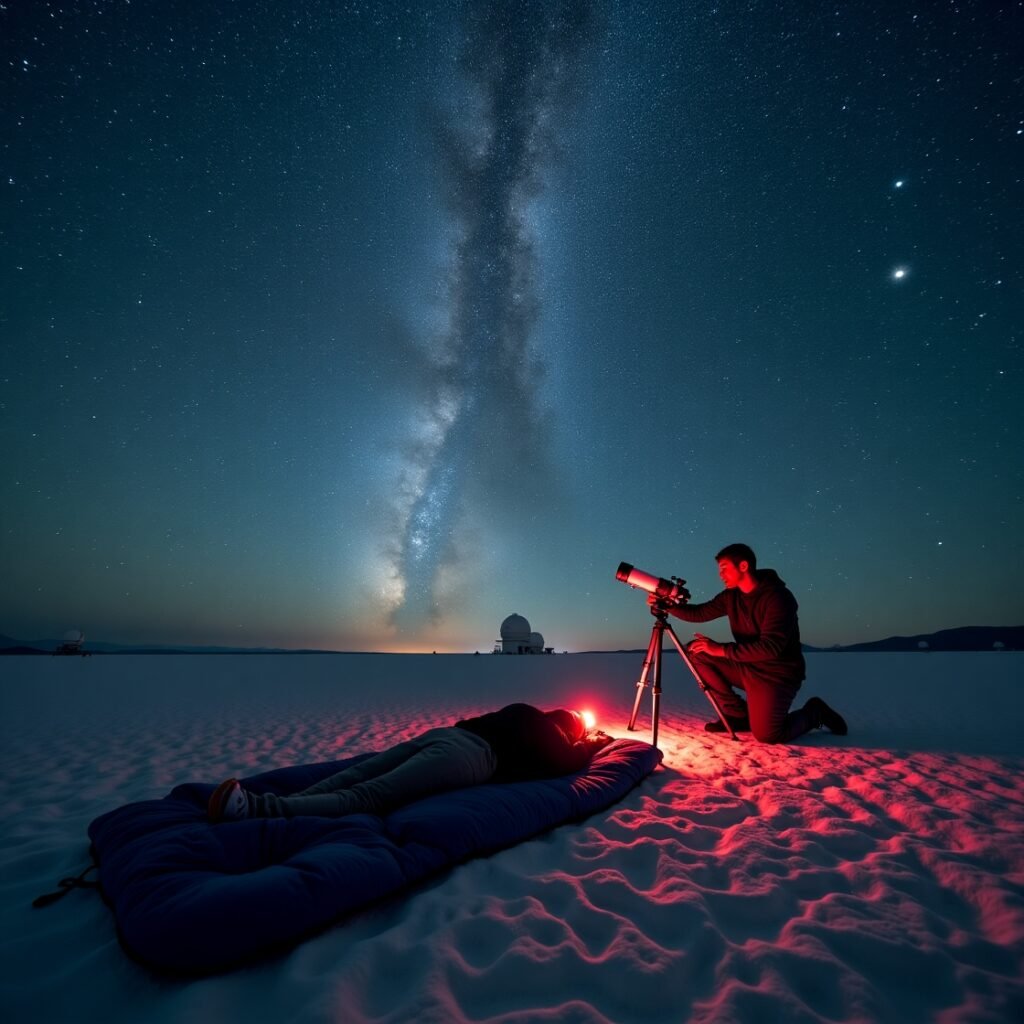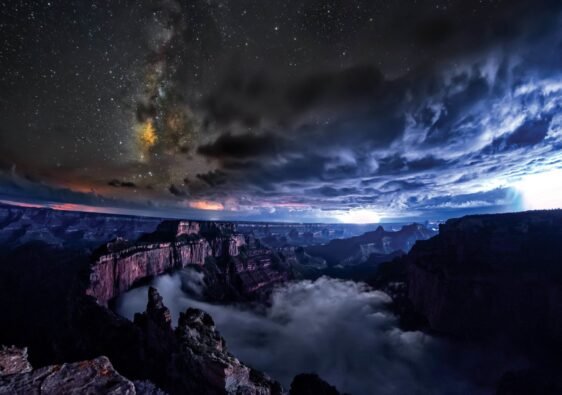
The first time I ventured out alone to stargaze, I made every rookie mistake possible. Dead phone battery at midnight in the Nevada desert. No red light, so I kept destroying my night vision every few minutes. Shivering in a cotton hoodie while 20-degree air cut through me like a blade.
But then I saw Saturn’s rings through borrowed binoculars—those perfect, impossible golden hoops floating in space—and everything changed. That moment of pure cosmic wonder made every mistake worth it.
Here’s everything you need to explore the night sky solo, safely, and successfully.
Chase the stars, not hotel check-ins. With RVezy, you can take your love of the night sky on the road. Rent an RV, motorhome, or travel trailer and set up camp under the clearest skies across North America. Every booking includes $2M insurance, 24/7 roadside assistance, and secure, bilingual support—so all you have to worry about is where to park for the perfect view of the Milky Way.
Get $25 off your USA booking with promo code RVEZYUSA25.
Book your stargazing getaway now at RVezy.com and experience the cosmos your way
Why Solo Stargazers Need a Different Approach
Group stargazing has its perks—shared knowledge, extra gear, someone to watch your back. But solo stargazing? That’s where the magic lives. Just you, the cosmos, and complete freedom to follow your curiosity wherever it leads.
The catch: when you’re alone under a dark sky, there’s no one to lend you a forgotten headlamp, help steady your camera, or point out that bright “star” that’s actually Jupiter. Self-reliance isn’t just smart—it’s essential.
This guide covers the 10 must-have items for solo night sky exploration, from absolute essentials to game-changing upgrades. Every recommendation has been field-tested across desert floors, mountain peaks, and backyard adventures.
The Non-Negotiable Essentials (Items 1-5)
1. Red Light Headlamp + Backup
Why it matters: Your eyes need 20-30 minutes to fully adapt to darkness. One flash of white light ruins everything and sends you back to square one.
What to buy: Any headlamp with a dedicated red LED mode. Petzl Tikka or Black Diamond Spot ($40) are reliable choices. Avoid headlamps that only have red filters over white LEDs—they’re dimmer and less effective.
Pro tip: Always pack a backup red flashlight. I learned this the hard way during a meteor shower in Montana when my headlamp died at 2 AM.
Budget hack: Tape red cellophane over a regular flashlight. Not ideal, but it works in a pinch.
2. Offline-Capable Astronomy App
The night sky is overwhelming without a guide. Even experienced stargazers use apps to identify planets, predict satellite passes, and locate deep-sky objects.
Top picks:
- SkySafari Plus: The gold standard. Works completely offline with detailed object information
- Star Walk 2: Beautiful interface, great for beginners
- Stellarium Mobile: Desktop astronomy software in your pocket
Critical feature: Download star maps before you leave civilization. Cell service and GPS can be spotty in the best dark-sky locations.
Game-changer: Use your app’s “red mode” to preserve night vision while navigating the sky.
3. Quality Binoculars (8×42 or 20×50)
Forget telescopes for your first solo adventures. Binoculars are lightweight, intuitive, and reveal incredible detail without the complexity of telescope setup and alignment.
Sweet spot specs:
- 8×42: Lighter, steadier handheld viewing, wider field of view
- 10×50: More magnification, better for faint objects, heavier
Recommended models:
- Budget: Celestron Outland X 8×42
- Mid-range: Celestron – Cometron 7×50 Binoculars
- Investment: Slokey 10×42 Binoculars
What you’ll see: Jupiter’s four largest moons, Saturn’s rings (barely), the Andromeda Galaxy, countless star clusters invisible to naked eyes.
4. Warm Layers (Yes, Even in Summer)
Heat escapes your body fastest when you’re motionless, and stargazing involves lots of sitting still. Desert locations that hit 90°F during the day regularly drop to 40°F after midnight.
Smart layering system:
- Base layer: Merino wool or synthetic thermal top and bottom
- Insulation: Down or synthetic puffy jacket
- Shell: Windproof/waterproof outer layer
- Accessories: Insulated hat, gloves, wool socks, neck gaiter
Personal lesson: I once spent four hours shivering through a meteor shower in Joshua Tree because I thought California meant warm nights. Don’t be me.
5. Comfortable Seating Solution
Craning your neck skyward for hours is a recipe for pain. You need something that lets you lie back comfortably while staying warm and dry.
Options by budget:
- Ultra-budget: Yoga mat or camping pad
- Comfort upgrade: Inflatable sleeping pad with pillow
- Luxury choice: Zero-gravity reclining chair
Pro tip: Test your seating at home first. What feels comfortable for 10 minutes might be torture after two hours.
The Game-Changers (Items 6-10)
6. Stable Tripod for Photography
Even smartphone astrophotography requires steady support for those stunning Milky Way shots you’ll want to capture.
Phone photography: Any lightweight tripod ($20-40) with a phone mount works perfectly Camera photography: Invest in carbon fiber for weight savings. K&F Concept and Peak Design make excellent travel tripods
Technique tip: Use your camera’s timer or a remote shutter release to eliminate shake during long exposures.
7. Portable Power Solution
Nothing kills a stargazing session faster than dead electronics. Your phone, headlamp, and camera all need juice for those long winter nights.
Capacity sweet spot: 10,000-20,000 mAh power bank
Bonus features: Look for models with built-in LED lanterns or wireless charging
Solar option: Solar Charger Power Bank Solar for multi-day adventures without power access
8. Stargazing Journal + Red Pen
Digital notes are convenient, but there’s something special about sketching Jupiter’s position or writing about your first glimpse of the Orion Nebula by red light.
What to record:
- Date, time, location, weather conditions
- Objects observed and sketches
- Personal thoughts and feelings
- Equipment used and settings
Format tip: Use a small hardbound notebook that lies flat. Moleskine or Rhodia work great.
9. Compact Telescope (Optional but Incredible)
Ready to see Saturn’s rings clearly or explore lunar craters? A small telescope opens up the universe without breaking your back.
Best travel scopes:
- Gskyer Telescope: Tiny but powerful, airline carry-on friendly
- Celestron StarSense Explore: Collapsible, lightweight, great optics
- Celestron NexStar 4SE ($600): Computerized goto system, finds objects automatically
Reality check: The best telescope is the one you’ll actually carry and use. Start with binoculars and upgrade when you’re hooked.
10. Safety and Communication Gear
Solo adventures in remote areas require extra safety precautions, especially at night.
Must-haves:
- Location sharing: Google Maps live sharing or Life360 app
- Emergency communication: Satellite communicator like Garmin inReach ($200-400)
- First aid basics: Bandages, pain relievers, emergency whistle
- Navigation backup: Physical map and compass as GPS backup
My Current Solo Stargazing Kit
After years of refinement, here’s what actually makes it into my pack for solo adventures:
Always packed:
- Petzl Tikka headlamp + backup red flashlight
- Nikon Aculon 10×50 binoculars
- SkySafari app (offline maps downloaded)
- Lightweight tripod + phone mount
- 20,000 mAh power bank
- Inflatable sleeping pad with pillow
- Complete layering system (base to shell)
- Stargazing journal + red pen
- Basic first aid kit
- Emergency whistle
Sometimes added:
- Celestron C90 telescope (special destinations)
- DSLR camera + wide-angle lens (photography focused trips)
- Thermos with hot tea or cocoa
- Portable camping chair (car camping only)
Total weight: 8-12 pounds depending on configuration.
Total cost: $400-600 for the complete kit
Location-Specific Considerations
Desert Stargazing (Atacama, Mojave, Sahara)
- Extra water: Dehydration happens fast in dry air
- Sun protection: For daytime setup and breakdown
- Sand-proof bags: Protect electronics from fine dust
Mountain Stargazing (Rockies, Alps, Andes)
- Altitude prep: Thinner air means less oxygen, more UV exposure
- Weather changes: Mountain weather shifts rapidly
- Emergency signaling: Satellite communicator is essential
Backyard Stargazing
- Light pollution filters: Help camera sensors cut through city glow
- Comfort upgrades: Since you’re close to home, bring the good chair
- Security awareness: Even familiar areas feel different at night
Common Solo Stargazing Mistakes (And How to Avoid Them)
Mistake #1: Checking your phone without red mode Fix: Set your phone to permanent night mode during stargazing sessions
Mistake #2: Overdressing for the current temperature Fix: Dress for the coldest hour (usually 3-5 AM), then layer down as needed
Mistake #3: Forgetting to tell someone your plans Fix: Always share your location and expected return time with a trusted contact
Mistake #4: Bringing too much gear on your first trip Fix: Start with the essentials, add items as you identify actual needs
Getting Started: Your First Solo Stargazing Adventure
Ready to begin? Here’s a simple progression:
Week 1: Start in your backyard or a nearby park with just binoculars and a red light. Learn the major constellations.
Week 2: Download an astronomy app and explore how to identify planets and bright deep-sky objects.
Week 3: Plan a short drive to a darker location. Practice with your complete kit for 2-3 hours.
Month 2: Take your first overnight solo stargazing trip to a designated dark-sky area.
The Real Magic Isn’t in the Gear
All this equipment serves one purpose: getting you comfortable enough to spend long, quiet hours under the stars. The telescope doesn’t create the wonder—you do. The red light doesn’t reveal the universe’s secrets—your curiosity does.
I’ve had profound stargazing experiences with nothing but my eyes and a blanket, and I’ve had forgettable nights despite perfect equipment and crystal-clear skies. The difference? Presence. Patience. A willingness to sit quietly and let the universe speak.
The gear just makes it easier to listen.
Your Next Step
The cosmos has been putting on this show for billions of years, waiting for you to look up and notice. You don’t need perfect equipment or pristine skies to begin—you just need to start.
Pick three items from this list. Find a dark spot within an hour’s drive. Check the weather forecast for a clear night. Go.
The stars are calling, and now you know how to answer.
Now get out there and make it happen



